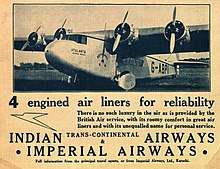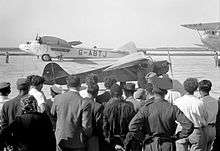Armstrong Whitworth Atalanta
The Armstrong Whitworth AW.15 Atalanta was a 1930s British four-engine airliner built by Sir W.G. Armstrong Whitworth Aircraft Limited at Coventry.
| AW.15 Atalanta | |
|---|---|
 | |
| AW.15 Atalanta "Artemis" | |
| Role | airliner |
| Manufacturer | Sir W.G. Armstrong Whitworth Aircraft Limited |
| First flight | 6 June 1932 |
| Introduction | 1933 |
| Retired | 1942 |
| Primary users | Imperial Airways Royal Air Force Indian Air Force |
| Number built | 8 |
Design and development
The AW.15 Atalanta was designed to meet a 1930 Imperial Airways requirement for a four-engined airliner for its African lines, in particular for the service between Kisumu in Kenya and Cape Town, South Africa. The specification called for an airliner that could carry nine passengers, three crew and a load of freight for 400 mi (640 km), cruising at 115 mph (185 km/h) at 9,000 ft (2,740 m). Imperial Airways had decided to standardise on four-engined aircraft to prevent the failure of a single engine causing forced landings.[1] The prototype, G-ABPI, was named Atalanta and first flown on 6 June 1932,[2] by Alan Campbell-Orde from Whitley Abbey.
The Atalanta was a high-wing monoplane with four 340 hp (250 kW) Armstrong Siddeley Serval III ten-cylinder (two rows of 5 cylinders) radial engines. Its composite construction included steel, plywood and fabric; the undercarriage was fixed but was streamlined to minimize drag. The overall design of the aircraft was rather modern, and somewhat closed the performance gap between British and American airliners.[3]
The aircraft had few design flaws and any teething problems were quickly overcome. The prototype was flown to Croydon Airport for acceptance by Imperial Airways, and on 26 September 1932, it flew a commercial service from Croydon to Brussels and Cologne.[4]
The Atalanta could carry up to 17 passengers but Imperial Airways limited the seating to nine for the planes on the Indian route and 11 on the African route.
On 20 October 1932, the prototype was damaged in a test flight due to fuel starvation. Armstrong Whitworth was embarrassed by the accident and renamed the third production machine (G-ABTI, Arethusa) as Atalanta, hoping nobody would notice the swap.[5]
Two derivatives of the Atalanta were proposed: the Jaguar-powered AW.25 and Panther-powered AW.26, but neither left the drawing board.
Operational history

Imperial Airways ordered eight aircraft which had all been delivered by 1933. The first service was flown from Croydon Airport to Brussels and then Cologne on 26 September 1932. The prototype G-ABPI left Croydon Airport on 5 January 1933 on a proving flight to Cape Town, South Africa. Three other aircraft joined it in South Africa to fly the service between Cape Town and Kisumu, although they proved to be too small for the traffic. On 1 July 1933, an Atalanta flew the first direct air mail service between London and Karachi. Two Indian-registered and two British-registered aircraft operated a Karachi-Calcutta service with was later extended to Rangoon and Singapore.
On 29 May 1933, G-ABTL flew through to Melbourne, Australia (arriving on 30 June) on a route survey flight.
Imperial withdrew the Atalanta from its African routes in 1937, with two being leased by Wilson Airways for operations in Kenya until July 1938. The African Atalantas were then transferred to India.[6]
Three aircraft were lost before the Second World War and the remaining five aircraft were taken over by BOAC. In March 1941, they were impressed into use by the Royal Air Force in India, being used to ferry reinforcements to Iraq in response to the Rashid Ali uprising.[6] In December 1941, they were handed over to the Indian Air Force for use on coastal reconnaissance duties, armed with a single .303 in (7.7 mm) machine gun operated by the navigator. The last patrol was flown on 30 August 1942 and the two survivors were transferred to transport duties where they continued in use until June 1944.[3][7][8]
Operators

Civil operators
- Indian Trans-Continental Airways
- Wilson Airways
Aircraft names and registrations

- Atalanta (c/n 740; G-ABPI, renamed Arethusa; later VT-AEF, DG453)
- Andromeda (c/n 741; G-ABTH)
- Arethusa (c/n 742; G-ABTI, renamed Atalanta; later DG451)
- Artemis (c/n 743; G-ABTJ; later DG452)
- Athena (c/n 744; G-ABTK)
- Astraea (c/n 784; G-ABTL; later DG450)
- Amalthea (c/n 785; G-ABTG)
- Aurora (c/n 786; G-ABTM, later VT-AEG, DG454)
Specifications

Data from Armstrong Whitworth Aircraft since 1913[9]
General characteristics
- Crew: 3
- Capacity: 9–17 passengers
- Length: 71 ft 6 in (21.79 m)
- Wingspan: 90 ft 0 in (27.43 m)
- Height: 14 ft 0 in (4.27 m) [nb 1]
- Wing area: 1,285 sq ft (119.4 m2)
- Empty weight: 14,832 lb (6,728 kg)
- Max takeoff weight: 21,000 lb (9,525 kg)
- Powerplant: 4 × Armstrong Siddeley Serval III 10-cylinder two-row air-cooled radial engine, 340 hp (250 kW) each
Performance
- Maximum speed: 156 mph (251 km/h, 136 kn) at 3,000 ft (910 m)
- Cruise speed: 118 mph (190 km/h, 103 kn) at 9,000 ft (2,700 m)
- Stall speed: 51 mph (82 km/h, 44 kn)
- Range: 640 mi (1,030 km, 560 nmi)
- Service ceiling: 14,200 ft (4,300 m)
- Rate of climb: 700 ft/min (3.6 m/s) [12]
- Time to altitude: 21.5 min to 9,000 ft (2,700 m)
See also
Related lists
- List of aircraft of Imperial Airways
References
- Footnotes
- Notes
- Tapper 1988, p. 219.
- Tapper 1988, p. 224.
- "Airlines and Airliners: Armstrong Whitworth Atalanta." century-of-flight.net. Retrieved: 2 July 2010.
- Williams Aeroplane Monthly October 1980, pp. 510–511.
- Tapper 1988, p. 227.
- Williams Aeroplane Monthly November 1980, p. 568.
- Williams Aeroplane Monthly November 1980, pp. 568, 570.
- Warne 1985, p. 5.
- Tapper 1988, pp. 253–254.
- Tapper 1988, p.253.
- Flight 6 July 1932, p.621.
- Jackson 1974, p. 54.
- Bibliography
- "The A.W. X.V Monoplane." Flight, 8 July 1932, pp. 619–623.
- "The A.W. X.V Monoplane" (continued). Flight, 15 July 1932, pp. 661–665.
- The Illustrated Encyclopedia of Aircraft (Part Work 1982-1985). London: Orbis Publishing, 1985.
- Jackson, A.J. British Civil Aircraft Since 1919, Volume 1. London: Putnam, 1974. ISBN 0-370-10006-9.
- Tapper, Oliver. Armstrong Whitworth Aircraft since 1913. London: Putnam, 1988. ISBN 0-85177-826-7.
- Warne, D. W. "In Defence of India". Air Enthusiast, Twenty-eight, July–October 1985. pp. 1–7. ISSN 0143-5450.
- Williams, Ray. "Atalanta - Part 1". Aeroplane Monthly, October 1980, Vol 8 No 10. pp. 506–511. ISSN 0143-7240.
- Williams, Ray. "Atalanta - Part 2". Aeroplane Monthly, November 1980, Vol 8 No 11. pp. 564–570. ISSN 0143-7240.
External links
| Wikimedia Commons has media related to Armstrong Whitworth Atalanta. |